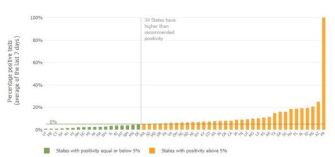
Backtracking slightly on his aggressive push for schools to reopen President Donald Trump conceded this week that some districts in areas heavily affected by the coronavirus may have to delay returning students to their buildings.
“In cities or states that are current hot spots—and you’ll see that in the map behind me—districts may need to delay reopening for a few weeks, and that’s possible,” Trump said at a White House briefing Thursday. “That’ll be up to governors. The decision should be made based on the data and the facts on the grounds in each community, but every district should be actively making preparations to open.”
Trump spoke hours before the Centers for Disease Control and Prevention released new guidance for schools.
Even as he’s insisted on “reopening the country,” Trump has vaguely referred to “putting out embers” and reacting to hot spots when the virus reemerges. But he’s never specified what level of virus transmission merits concern.
So what counts as a hot spot?
“Right now we’re looking where the percent positivity rate within the community is greater than 5 percent,” CDC Director Robert Redfield told reporters on a press call Friday.
Positivity rate refers to the percentage of COVID-19 tests performed in a given area that come back positive. A higher positivity rate may indicate more person-to-person spread within a region and a higher likelihood of exposure to the virus in public places or crowds.
The World Health Organization has said that before reopening, positivity rates be at or below 5 percent for at least 14 days. The state of New York and some school districts have used that criteria to determine when it is safe to return to school buildings.
According to data tracked by the John Hopkins University Research Center, 34 states have positivity rates above 5 percent.

Redfield said Friday that it’s important for schools to focus on “more granular” data, looking at the rate in their city or region to determine if it’s safe to reopen. But in some of the most heavily affected states, positivity rates are high in multiple areas.
Consider Florida, one of the states that has seen the biggest spikes in coronavirus cases. Trump and U.S. Secretary of Education Betsy DeVos have praised the state’s education commissioner for a directive that calls on schools to open for five days a week of in-person instruction for any family who wants that option. But many counties in the Sunshine State have positivity rates well above five percent, state data show.
The state’s overall positivity rate is about 12 percent. In Miami-Dade County, it’s 18 percent, state data show. In Duvall County—where Republicans were scheduled to hold national convention events until Trump cancelled them Thursday—the positivity rate is 10.6 percent. Many other counties also surpass the 5 percent threshold.

Many districts in Florida have opted to delay reopenings to start with hybrid or remote model, citing high infection rates and concern from parents and teachers.
A Push to Open Schools
The CDC’s new guidance on reopening schools stresses the importance of in-person learning.
“There is mixed evidence about whether returning to school results in increased transmission or outbreaks,” says a document for administrators on preparing to return to school, which was included in the new guidance. “For example, Denmark initially reported a slight increase in cases in the community after reopening schools and child-care centers for students aged 2-12 years, followed by steady declines in cases among children between ages 1 and 19 years.”
“In contrast, Israel experienced a surge of new cases and outbreaks in schools after reopening and relaxing social distancing measures; it is unclear what caused the increase ... " the document continues. “In summer 2020, Texas reported more than 1,300 COVID-19 cases in child-care centers; however, twice as many staff members had been diagnosed as children, suggesting that children may be at lower risk of getting COVID-19 than adults.”
Many school districts around the country have opted to start the 2020-21 academic year with remote learning. Trump, DeVos, and other officials have criticized those decisions, who have said education funding “should follow students,” allowing them to attend private schools if their public schools don’t open in person. As the White House and Senate Republicans draft their pitch for the next federal relief bill, they are weighing directing some federal funding to private school scholarships.
Education organizations and teachers’ unions have criticized the administration’s approach, saying public schools need more support to whether unprecedented circumstances.
“Educators want to be back in their classrooms—and they agree with the CDC that remote learning isn’t ideal—but the safety and health of students and staff must be paramount, particularly given the surge of COVID-19 in the South and West, and the new research about young people spreading the virus,” American Federation of Teachers President Randi Weingarten said in a statement Friday. “Let’s stop the debate about whether safety matters and start rolling up our sleeves so we get the resources to meet the needs of students, whether we are teaching remotely or in person.”
Reporters asked White House Press Secretary Kayleigh McEnany about the White House school choice push, and about Trump’s position on school openings at a press briefing Friday.
“The child, if a school is closed, loses the opportunity to get education and needed social services,” she said.
McEnany said students would be safe in school if they follow CDC guidelines related to precautions like social distancing. But administration officials have also said those guidelines shouldn’t serve as a “barrier to reopening.” Some districts have said it would be impossible to open at full capacity while keeping students spaced six feet apart.
Photo: President Donald Trump gestures towards a graphic on the coronavirus outbreak as he speaks during a news conference at the White House Thursday. --Evan Vucci/AP
